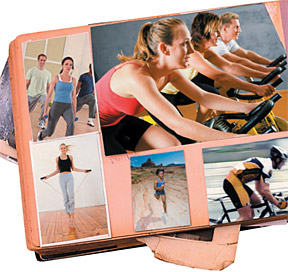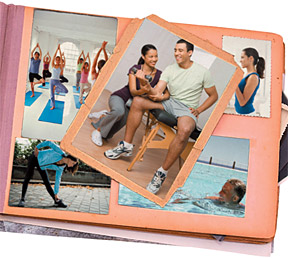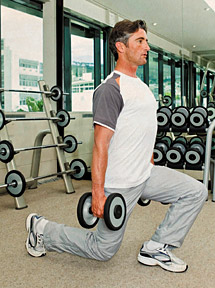Are you coming up with reasons not to exercise? The number-one reason I hear from people for why they don’t exercise is, “I don’t have time.” Really! I know everyone is busy, but all it takes is being flexible and having a bit of determination. Studies show that a little bit of exercise every day – even 10 minutes – helps. I ask my clients for 30 minutes a day, but if that seems too daunting to begin with, start with less. Don’t get stuck feeling that you must take the “all or nothing” approach. Aim to exercise two to three times a week, and add more sessions as you find ways to fit them in.
I consistently exercise in the morning, but I understand that for many people, mornings are hectic and trying to squeeze a workout in is impossible. Research actually shows there are benefits to working out at any time of the day, even if it’s half an hour before bedtime.
Key Principles
I love putting together a series of exercises into a workout known as circuit training. Circuit training is doing a number of exercises back to back (short exercise bursts with intensity), including a short recovery or break between exercises. I can add in cardio exercise such as running in place, jumping rope, or using equipment such as a treadmill, elliptical or stair-stepper.

I am going to teach you how to put together a combination of exercises in a circuit format. It’s a great technique to focus on strength and cardiovascular training and sculpt your own body. You can experiment with a large variety of exercises and equipment at whatever intensity you choose. You compete only with yourself, and you don’t have to be in sync with others.
Circuits can include exercise with one or both feet on the ground, your own body weight, stability balls, rocker boards, and various resistance devices like bands, free weights, kettlebells, machines or cables. You can isolate muscles or perform multi-joint / multi-muscle exercises that involve the whole body; and all the while the circuit is cardio-inspired because of the moves. A well-rounded exercise program should include flexibility training, strength training, endurance training, balance training, trunk (core) stabilization exercises and speed training. You should easily be able to modify the intensity and complexity of the circuit.
A cardio-resistance class is probably offered at your gym or fitness center. They put together a multi-station circuit for about 5-25+ people. Usually the total amount of circuit time can be 50-60 minutes, which allows participants to complete the circuit three times.
Design Your Own Program

If you don’t have access to a gym or don’t have time to go to the gym, I want you to create your own circuit at home. All you’ll need is an exercise mat, a pair of free weights or a kettlebell, a step platform (a chair or bench works, too), a stability ball, a medicine ball (2-5 pounds) and a pull-up bar. There are even online circuit clocks that act like an instructor, letting you know when to start and finish each exercise station. Put on your favorite music and start working out.
I usually allow 30 seconds for each exercise, and I choreograph my program ahead of time. It is important to start your circuit with a full-body, dynamic-movement warm-up. This prepares the muscles and joints for the forces and mechanics of the exercises ahead. Give yourself a full 10-minute warm-up and if that is all the time you have to exercise that day, that’s OK! If you can keep going, anywhere from 25-50 minutes after warming up, you’ll get a fantastic workout.
Here’s the basic concept:
- Perform a designated exercise for a predetermined time (usually 30 seconds) and, when prompted by the clock, move to the next exercise.
- Give yourself 15-30 seconds to set up for the next exercise.
- Pick about 10-12 exercises ahead of time, alternating between strength and cardio. For all strength exercises, you should be able to complete a minimum of 12 repetitions, but since the stations are time-based, keep going until signaled to end. For cardio exercises, keep moving for the allotted time. You can change the length at each exercise station and make it last anywhere from 30 seconds to one-and-a-half minutes; just keep the prep and recovery time the same (about 30 seconds).
A Sample 10-Station Circuit
Station 1: Strength. Equipment: balance trainer (ball) or balance pad (several varieties are available). Position: on all fours, right knee on ball, left knee and both hands on floor. Exercise Description: Lift and extend the right arm and left leg. Perform flexion and extension for 12 reps or until prompted by the clock to change sides. Repeat entire sequence on opposite side. (This exercise is good for the back.)
Station 2: Cardio. Equipment: step platform. Position: standing, facing the platform. Exercise Description: Squat-jump onto platform, then step down (alternate lead leg down; modify squat-jump as needed). Let arms assist by moving upward during jump.
Station 3: Strength. Equipment: stability ball. Position: kneeling, hands and forearms on stability ball. Exercise Description: Perform a forward roll-out, engaging the torso and lowering buttocks to create plank position from shoulders to knees. Roll back to start; perform 12 reps or until time is up. (Good exercise for the abdominals.)
Station 4: Cardio. Equipment: jump rope (if you don’t have a rope, imagine you are using one). Position: standing. Exercise Description: Perform movements with legs and arms.
Station 5: Strength. Equipment: chin-up bar. Position: hanging from the bar. Exercise Description: Perform pull-ups. This exercise taxes your entire upper body, and performing them correctly (pulling your chest up to the bar, retracting your shoulder blades and contracting the muscles in your upper back) leads to improvements in strength and appearance. And if you can’t do pull-ups, then use a small step or foot stool to help you start in the “up” position and slowly lower yourself down. Assist yourself up with the step or stool.
Station 6: Cardio. Equipment: a kettlebell. Position: standing. Exercise Description: Place the kettlebell arms distance in front of you between your feet. Stand a little more than shoulder-width apart. Do not stand too wide. The wider you stand, the less hip drive you will have. Push back with your butt and bend your knees to get into the starting position. Make sure your back is flat and look straight ahead. Swing the kettlebell between your thighs forcefully.
Quickly reverse the direction and drive through with your hips, taking the kettlebell straight out to chest level. Let the kettlebell swing back between your thighs and repeat until you reach the time limit.
The swing is one of the best ballistic exercises that you can do with kettlebells. It takes tremendous hip drive and hamstring power to drive against the kettlebell and to project it to chest level. In addition to building powerful, rapid hip action, the swing is an excellent hamstring exercise that carries over well to other exercises such as the barbell deadlift. The swing is also a tremendous core exercise, as you really have to brace yourself as the kettlebell swings between your legs.

Station 7: Strength. Equipment: your own body-weight. Position: push-up. Exercise Description: Push-ups are another great upper-body builder for your chest, shoulders, back and arms. But mix it up by putting a medicine ball under your hands, do them with your hands around free weights, do them with different hand positions, wear a weighted vest, or try them inverted. The push-up is a great “basic” movement that can be modified for all levels.
Station 8: Cardio. Equipment: body-weight. Position: mountain climber (start in a push-up position). Exercise Description: Assume a push-up position with your arms completely straight. Your body should form a straight line from your head to your ankles. Without allowing your lower-back posture to change, lift your right foot off the floor and slowly move your right knee toward your chest. Return to the starting position and repeat with your left leg. Alternate back and forth for the duration of the set.
Station 9: Strength. Equipment: body-weight. Position: standing (lunge). Exercises Description: Lunges. I love lunges because they target the entire lower body. And when you are looking to get the most bang for your buck, focus on training the big muscles like the glutes and quads. Again, you can diversify the types of lunges you do: straight, angled, reverse, side, cross-behind. Have fun with it, but they’ll surely work your entire lower body.
Station 10: Cardio. Equipment: body-weight. Position: standing split jump. Exercise Description: Stand in a staggered stance with your feet 2 to 3 feet apart, your right foot in front of your left. Keeping your torso upright, bend your legs and lower your body into a lunge. Now jump with enough force to propel both feet off the floor. While you’re in the air, scissor-kick your legs so you land with your left leg forward. Repeat, alternating your forward leg for the duration of the set time.
A new year’s right around the corner; make it your healthiest year ever by following these exercise principles and engaging your entire body. Remember, if you say you don’t have the time, you’re just making excuses! Get started today and see how much better you look and feel. Talk to your doctor if you have questions about how to perform any of these exercises or if a health condition may limit your ability to perform any of the above.

Circuit Training Tips
- Create stations that challenge you and don’t require a considerable amount of set-up time.
- Try to increase the number of repetitions you can perform in the same amount of time each week. Use the “one more rep” mentality.
- Make sure you maintain good body alignment and core engagement throughout.
- Warm up before the circuit and cool down after it.
- Don’t forget the fun factor!
By Dr. Jeffrey Tucker